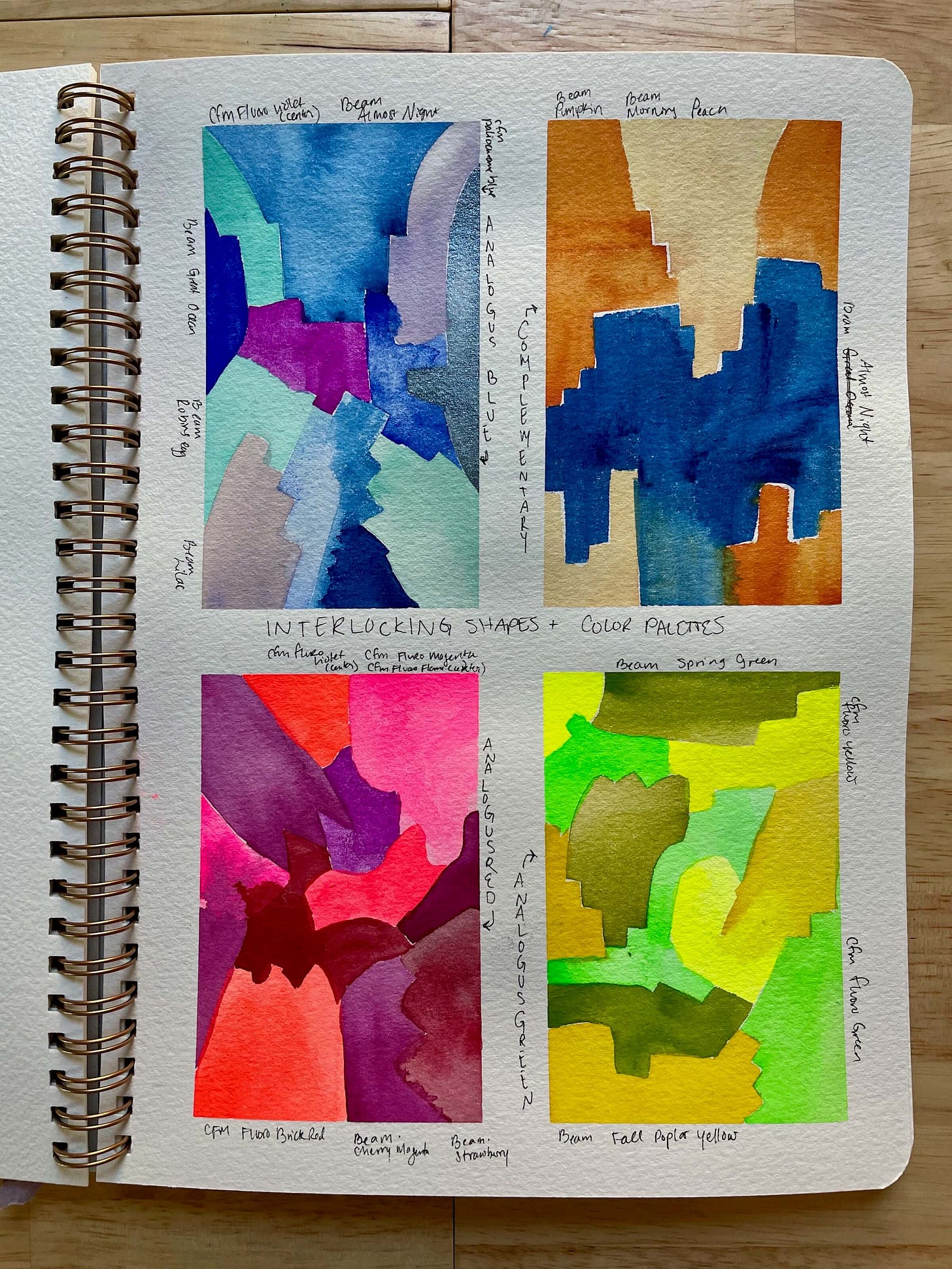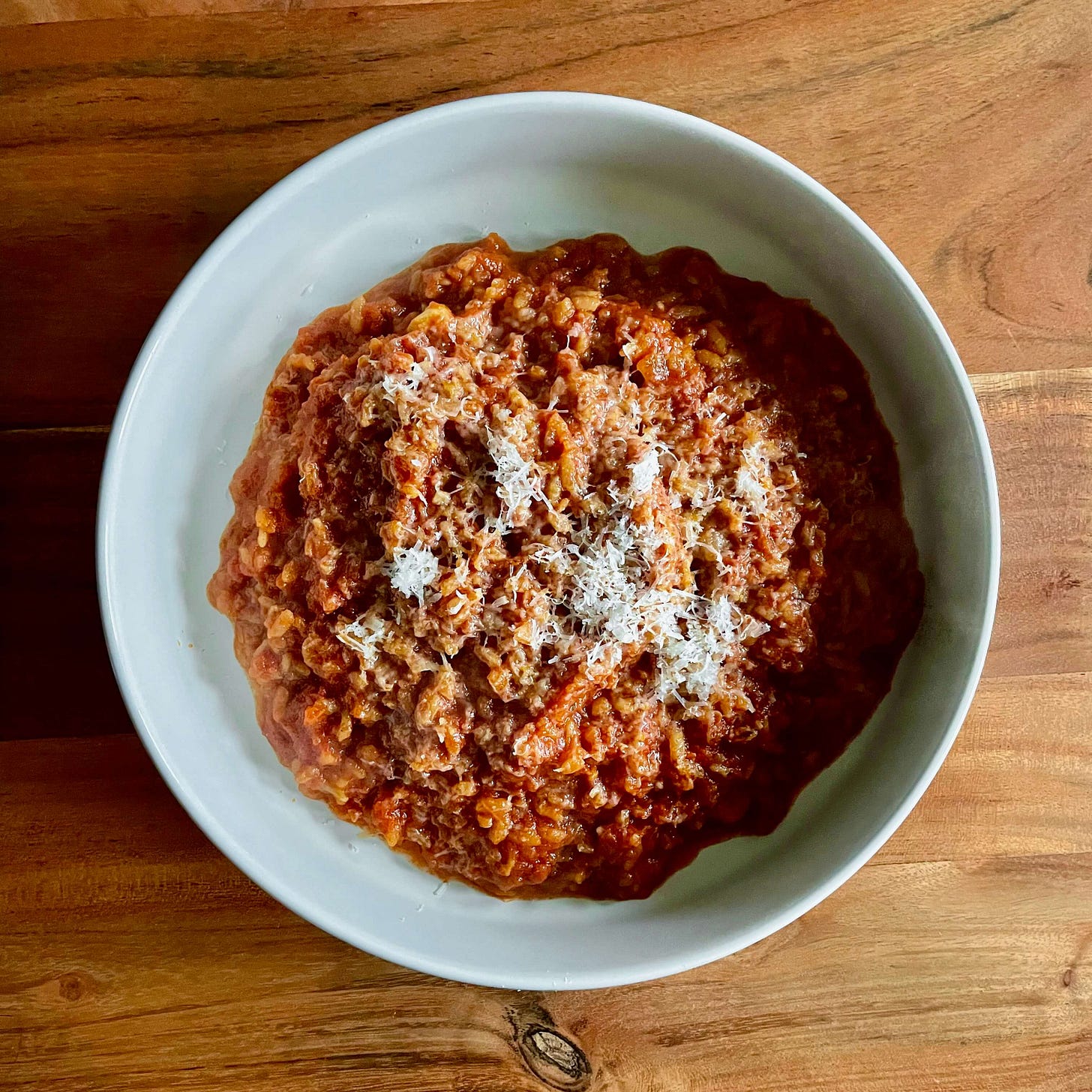Don't Make This: Risotto All'Assassina
How prompts and constraints sometimes inspire creativity and sometimes get in the way. Also: painting, poetry, and Buzzfeed.
If I’ve learned anything from a lifetime of throwing myself at creative projects, it’s that art is about solving problems.
I don’t think it matters what the art form is. I have painting and poetry on the brain right now, but I think it applies equally to knitting, pottery, printmaking, and whatever else you can think of.
Part of what makes Good Art interesting is its ability to metabolize a constraint and disappear it into its corpus.
With any art, there’s always the question of how you get from one thing to another. You have life, and you have whatever materials you’re working with, and somehow you have to make one describe the other.
And then, there are the constraints. If I’m painting, I’m constrained (at minimum) by my paper; paints; brush; pen, pencil, or lack thereof. If I want to make it more interesting, I limit my tools even further.
The paintings below were all prompted by Lisa Solomon’s Color Meditation creative prompt deck. You draw one or two (or more) cards, then see where it leads you. Here, I drew “Interlocking Shapes” and “Color Palette”.

I wasn’t trying to create anything. I just explored. Each one of these little studies is its own world. The blue painting makes me feel calm and energized, like one of rare days when I’ve stumbled into Figuring It Out, and I’ve slept enough and eaten enough and have the right conditions to fall right into a flow state. The complementary blue/orange painting makes me feel like I’m on the verge of Discovering Something.
Let’s look at two more examples.

On the left, I have five glimpses into one world. On the right, I have glimpses into two different worlds, or two very different places in the same world. One of these pages shows the range that three colors can cover. The other explores how deep a limited range can go.
Part of what makes Good Art interesting is its ability to metabolize a constraint and disappear it into its corpus.
Still looking at the paintings above, the sketches on the left side are more cohesive than the sketches on the right. Especially the pink-and-blue sketch on the bottom right—what’s going on there? Answer: I didn’t know what to do with pink and blue, panicked, and threw some abstract lines on top. Fine, but not as consistent as the alien landscapes of the left-side page. The orange, brown, and indigo support each other. There isn’t a reason for the pink and blue to be together other than the limitation of the palette.
What I’m saying is: constraints are great. Even if I can’t figure out how to make a constrained piece of art succeed, I usually learn something from the process.
Let’s look at a constrained poem, just because we can, and then we’ll get to the risotto. I promise. Here’s the first seven lines of Daniel Schonning’s “Abecedarian ‘G’”—a poem which takes the alphabet as the basis of its form, as seen in the first letter of each line.
What I love about Schonning’s poem is his ability to disappear the form into the poem. “Abecedarian ‘G’” cannot exist without the structure of the alphabet marching ever onwards, line by line, yet if he didn’t tell me I was reading an abecedarian, I won’t take for granted that I would notice that I was.
One way an abecedarian can trap the writer is by the difficult letters. Start a line with an x or a q or a z and immediately the reader goes Hey! That’s an unusual word!
Schonning avoids that trap by giving us an x long before he needs to. In fact, he does it twice. In the first strophe, screenshotted above, “a real doozy of a crossword clue that I just can’t get—eight letters, ends with an x.” In the second, “keep x-ing the boxes on his to-do list”. He arrives at the x-line in the third strophe with “…the pier’s / x-shaped pilons”, and because it’s not the first x the poem offers, it doesn’t stick out. It’s no longer a requirement he has to tick to complete the abecedarian form. It’s just another x in a poem that uses xs.
To hammer this home, he remembers the x in the final lines of the poem: “He slips his gloves into his back pocket, takes up his list and marks one box with an x.” X is a crossword clue, a to-do-list item, a pilon. Schonning embraces the x and makes it a critical component of the poem. It’s such an elegant trick, and it’s a key part of how the form and content merge into one whole.
(He does this with another letter1, visible in the screnshot above—can you see it? Answer in the footnote).
So why am I spending all this time analyzing sketches and poetry in a newsletter about risotto?
If I want to make risotto, I have to make risotto.
You already have the first part, I’m sure. Risotto Tuesday has to be risotto. That’s a constraint! A pretty flexible one, as constraints go, but if I want to make risotto, I have to make risotto.
Sometimes that’s enough. Risotto + a few seasonal ingredients, and there’s dinner. Lemon risotto. Wonderful, simple, somebody else’s recipe. Done.
Sometimes though, there’s enough time and mental headspace to plot out something a little wilder—Samosa Risotto, for example.
Enter Buzzfeed.




I’m not on TikTok, but I read TikTok coverage on Buzzfeed, which is probably definitely worse. According to Buzzfeed, spaghetti all’assassina is going viral in some circles over on the clock app.
Spaghetti al’assassina is a simple Italian recipe where spaghetti is cooked directly in tomato sauce in a wide pan. You leave it alone for awhile so the pasta gets deeply caramelized, almost burnt. With risotto and pasta being close cousins, I thought hey. Here’s a creative prompt.
I had constraints in the form of the existing dish: limiting my ingredients to the ones used for pasta, and trying to mimic the original dish as closely as possible.
I also faced an immediate problem. Risotto relies on starch release from stirring, and spaghetti all’assassina requires you don’t stir the pasta, ignoring it so it toasts and the tomato sauce caramelizes.
My solution: Toast the rice much further than usual for risotto, taking it all the way to a golden color, and roast canned tomatoes ahead of time to add a deeper tomato flavor.
Unfortunately, toasting the rice to such an extent limited its ability to behave nicely, roasting tomatoes wasn’t enough to make up for the raw tomato passata, and we ended up with crunchy risotto that one person compared to Spaghetti-Os. Which absolutely meant as compliment, but not at all what I was aiming for.
If I were to try to improve it, I would….
Roast more canned tomatoes and puree them, adding the puree to the nearly-finished risotto as one of the
Skip the passata and use plain water instead (maybe water+red pepper flakes and/or a few Italian herbs), relying on the roasted tomato puree at the end to deliver flavor
Maybe one day I’ll make a bangin’ Spaghetti-Os risotto. Until then, here’s risotto all’assassina, which I don’t recommend making unless you want to have a go at improving it 😜
Risotto All’Assassina
Serves 3-4
Ingredients
1 28 oz can whole peeled tomatoes
1 14 oz can diced tomatoes
1 jar (approx.) 500 ml tomato passata, or pureed tomatoes
1-2 tbsp. red pepper flakes
1 onion, diced
1 5 oz can tomato paste
1 c arborio rice
1/2 c white wine
1 c finely grated Parmesan or similar cheese
Olive oil
Salt
Pepper
Roast the Tomatoes (Method)
Preheat the oven to 350° F. Line a baking tray with parchment paper.
Separate the tomatoes and diced tomatoes from the tomato juice in their cans.
Add the juices to a small saucepan along with the tomato passata, salt, and about 1 tablespoon red pepper flakes (depending on how spicy you like things) and set to simmer over low heat.
Halve the whole tomatoes or tear into pieces with your hands.
Spread the tomatoes on the parchment, drizzle with olive oil and salt. Roast until they are dark and caramelized, about 75 minutes. Set aside.
Toast the Rice
Heat about 2 tablespoons olive oil in Dutch oven over medium-low heat. Add the rice and toast until golden brown. It will happen very slowly at first, and then all at once. Stir often, and watch closely to prevent burning, especially as it takes on color. It will take at least 10 minutes (at the barest minimum).
Remove from heat. Scrape into a bowl and reserve.
Make the Risotto
Add another tablespoon of olive oil to the Dutch oven if needed. Cook the onion on medium-low heat until entirely tender.
Add the tomato paste and stir to combine. Cook until tomato paste is dark and caramelized, stirring occasionally.
Add the toasted rice, stirring to combine
Add the wine, whisking vigorously until absorbed and scraping up any tomato paste stuck to the bottom of the pan.
Add the roasted tomatoes and stir.
Add the tomato broth, one ladle at a time, waiting until each is absorbed before adding the next.
When rice is tender and cooked through (albeit somewhat crunchy thanks to the toasting), and the risotto is thick and starchy, add the parmesan.
Serve in bowls topped with extra parmesan.
Lastly, thanks again to
for the shoutout in the most recent edition of , talking about food and creativity and the burnout that can come from professionalizing your hobbies. Go check it out if you haven’t already!Happy creating. See you in a week,
Shell 🐚
Schonning works this way with the m-line as well. The poem opens “God says to the meek one,” introducing the “meek one” as a character, so when the m-line comes along, there the “meek one” is again.







I will not be trying this risotto but I'm obsessed with how you made such a good story out of such an underwhelming dish